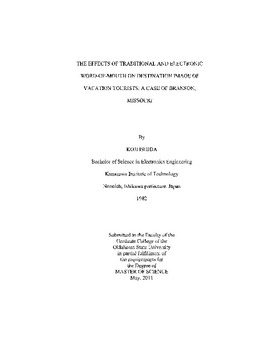| dc.contributor.advisor | Slevitch, Lisa | |
| dc.contributor.author | Ishida, Koji | |
| dc.date.accessioned | 2014-04-16T03:08:55Z | |
| dc.date.available | 2014-04-16T03:08:55Z | |
| dc.date.issued | 2011-05-01 | |
| dc.identifier.uri | https://hdl.handle.net/11244/9689 | |
| dc.description.abstract | Word-of-Mouth effect on products decision-making have been studied for over 40 years. However, the effects of integrated word-of-mouth (WOM), both traditional and electronic, on tourism products are yet to be investigated. This study aims to assess the effects of and differences between traditional WOM and electronic WOM, the effects of and differences between personal WOM and commercial WOM, and the effects of and differences between positive and negative WOM in both traditional and electronic WOM on perceived destination image. Online and face-to-face surveys were used to collect the data from visitors who have visited Branson in the past and have registered with tourists' data base in Branson, Missouri, Chamber of Commerce. Face-to-face survey was also administered to visitors who had visited Branson Welcome Center during the survey period. A descriptive design using a cross-sectional sample survey was used to collect data for the proposed research hypotheses, which were later tested using ANOVA and regression analysis. Results of the study indicated that traditional WOM has a greater influence on destination image compared to electronic WOM. Personal WOM has a greater influence on destination image compared to commercial WOM. However, negative WOM exerts less influence on destination image compared to positive WOM while negative electronic WOM has a greater influence on destination image compared to negative traditional WOM. These results support the proposed hypotheses only partially. Tourists' brand relationship with electronic WOM communicator, expertise, and WOM information configuration may act as a moderator in this study. Accordingly, asymmetric dimensions of WOM effects on destination image were found. More integrated future research is needed to reveal the mechanics of WOM effects on destination image for the purpose of marketing strategy. | |
| dc.format | application/pdf | |
| dc.language | en_US | |
| dc.publisher | Oklahoma State University | |
| dc.rights | Copyright is held by the author who has granted the Oklahoma State University Library the non-exclusive right to share this material in its institutional repository. Contact Digital Library Services at lib-dls@okstate.edu or 405-744-9161 for the permission policy on the use, reproduction or distribution of this material. | |
| dc.title | Effects of Traditional and Electronic Word-of-mouth on Destination Image of Vacation Tourists: a Case of Branson, Missouri | |
| dc.type | text | |
| dc.contributor.committeeMember | Hancer, Murat | |
| dc.contributor.committeeMember | Njite, David | |
| osu.filename | Ishida_okstate_0664M_11223.pdf | |
| osu.college | Human Environmental Sciences | |
| osu.accesstype | Open Access | |
| dc.description.department | School of Hotel and Restaurant Administration | |
| dc.type.genre | Thesis | |
| dc.subject.keywords | destination image | |
| dc.subject.keywords | electronic word-of-mouth | |
| dc.subject.keywords | ewom | |
| dc.subject.keywords | traditional word-of-mouth | |
| dc.subject.keywords | wom | |
| dc.subject.keywords | word-of-mouth | |
